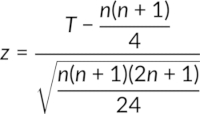13.7 : Wilcoxon Signed-Ranks Test for Matched Pairs
The Wilcoxon signed-rank test for matched pairs evaluates the null hypothesis by combining the ranks of differences with their signs. It essentially tests whether the median of the differences in a population of matched pairs is zero. Since the test incorporates more information than the sign test, it generally yields more trustable conclusions. This test also does not require the data to follow a normal distribution, but two conditions must be met for it to be applicable: (1) the data must consist of matched pairs; and (2) the distribution of the differences between these pairs should be approximately symmetric.
The difference, d, for each data pair is calculated by subtracting the second value from the first. In the Wilcoxon signed-rank test, the signs of these differences are initially ignored, and their absolute values are ranked in ascending order, and ranks are then assigned to each difference. After that, the original signs are reapplied to the ranks, creating signed ranks. The sum of the positive and negative signed ranks is calculated separately. With this, the sample size, n, is the number of pairs with non-zero differences, which determines the test statistic used.
- If n is less than equal to 30, the test statistic, T, is taken as the smallest of the two sums obtained;
- If n is higher than 30, the test statistic, Z, is calculated using the formula: 14160_Equation_PT_1

In both cases, the critical z-value is also up from its table. If the test statistic, T, is less than the critical value, z, the null hypothesis is rejected.
Del capítulo 13:

Now Playing
13.7 : Wilcoxon Signed-Ranks Test for Matched Pairs
Nonparametric Statistics
84 Vistas

13.1 : Introduction to Nonparametric Statistics
Nonparametric Statistics
660 Vistas

13.2 : Ranks
Nonparametric Statistics
225 Vistas

13.3 : Introduction to the Sign Test
Nonparametric Statistics
675 Vistas

13.4 : Sign Test for Matched Pairs
Nonparametric Statistics
97 Vistas

13.5 : Sign Test for Nominal Data
Nonparametric Statistics
70 Vistas

13.6 : Sign Test for Median of Single Population
Nonparametric Statistics
89 Vistas

13.8 : Wilcoxon Signed-Ranks Test for Median of Single Population
Nonparametric Statistics
97 Vistas

13.9 : Wilcoxon Rank-Sum Test
Nonparametric Statistics
147 Vistas

13.10 : Bootstrapping
Nonparametric Statistics
583 Vistas

13.11 : The Anderson-Darling Test
Nonparametric Statistics
657 Vistas

13.12 : Spearman's Rank Correlation Test
Nonparametric Statistics
672 Vistas

13.13 : Kendall's Tau Test
Nonparametric Statistics
587 Vistas

13.14 : Kruskal-Wallis Test
Nonparametric Statistics
553 Vistas

13.15 : Wald-Wolfowitz Runs Test I
Nonparametric Statistics
604 Vistas
See More
ACERCA DE JoVE
Copyright © 2025 MyJoVE Corporation. Todos los derechos reservados